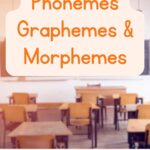All About Phonemes, Graphemes, and Morphemes
This post may contain affiliate links. As an Amazon affiliate, we earn from qualifying purchases.
Learn all about phonemes, graphemes, and morphemes. Learn what these terms mean, their importance in the field of literacy, and the power of teaching phoneme-grapheme correspondences and morphemic analysis.
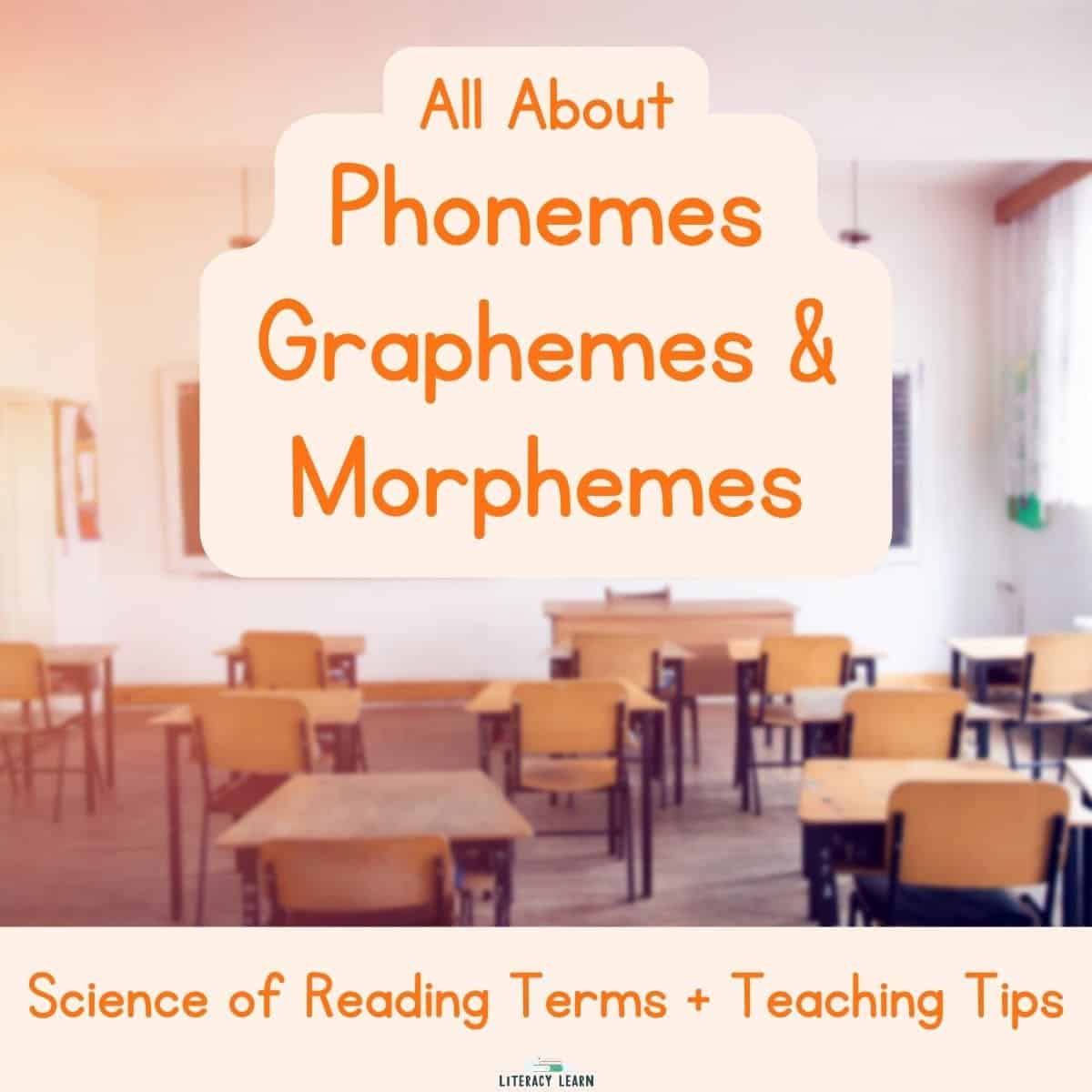
Phonemes, Graphemes, & Morphemes
The terms phonemes, grapheme, and morpheme have a few things in common as they relate to the structure of the English language. But they also are unique and include important differences that distinguish them from one another.
These academic terms have become more common as teachers, parents, and others become more educated in Orton-Gillingham methodology, more recently referred to as Structured Literacy.
Let’s start by looking at what the words have in common. Considering word parts will help tremendously. Below, we break the words down into word sums to understand the literal meaning of the terms.
All three terms include the word part “-eme” at the end, which means “little bit.”
- Phon (sound) + eme (little bit) = little bit of sound.
- Graph (writing) + eme (little bit) = little bit of writing.
- Morph (form/shape) + eme (little bit) = little bit of form or shape.
All of these terms are important as they relate to literacy. Now although the three words include the same word part “-eme,” they have important differences that uniquely distinguish them from one another!
Keep reading to learn the differences between phonemes, graphemes, and morphemes.
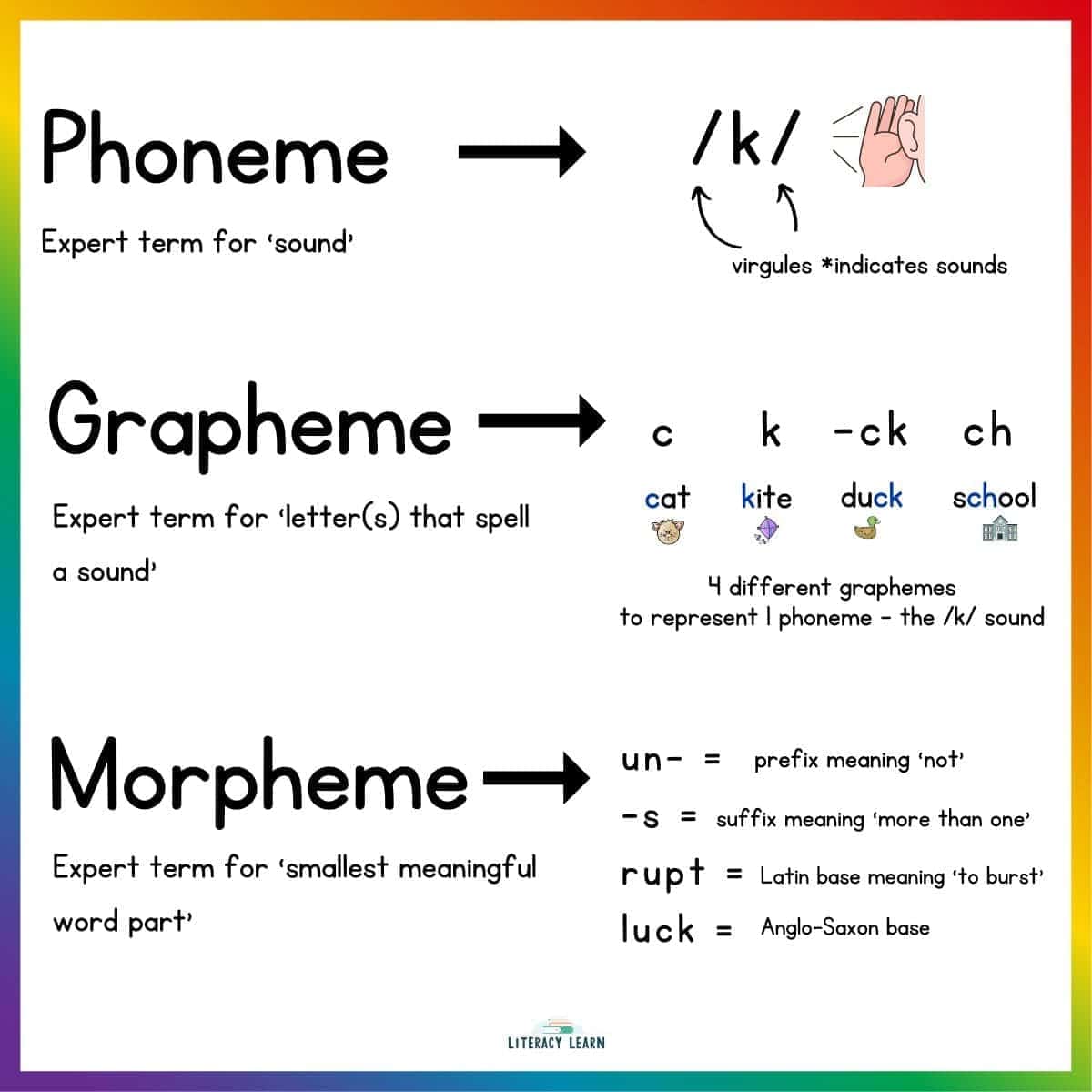
🔊 What Is a Phoneme?
Definition of Phoneme: A phoneme is a small unit of sound.
Phonemes are all about the sounds, not the letters. So when you hear the word phoneme, think ‘sound.’ In English, we have approximately 44 phonemes.
Phonemes are important to distinguishing one word from another. For example, the words “cat” and “rat” differ by just one phoneme – /k/ and /r/ – which makes them completely different words with different meanings.
When we write sounds, we use two slashes called virgules that look like this: / /. When you see this: /k/, you should say the sound /k/, not the letter K.
Here are some examples of words broken apart into their phonemes:
| Example Word | # of Phonemes | |||
| chair | 3 | /ch/ | /ā/ | /r/ |
| thought | 3 | /th/ | /aw/ | /t/ |
| hung | 3 | /h/ | /ŭ/ | /ŋ/ |
| days | 3 | /d/ | /ā/ | /z/ |
🔠 What Is a Grapheme?
Definition of Grapheme: A grapheme is a letter or letters that represent a sound.
Graphemes are the written representations of sounds in a language. So when you hear the word grapheme, think ‘letters.’
A grapheme can be a single letter, like ‘t’, ‘f’, or ‘l’, or a combination of letters (phonograms), like the digraphs (sh, ch, th), vowel teams (ai, ay, ea), r-controlled vowels (ar, er, ir) and trigraphs (-tch, -dge).
Here are some examples of words broken apart into the graphemes:
| Example Word | |||
| chair | ch | ai | r |
| thought | th | ough | t |
| hung | h | u | ng |
| days | d | ay | s |
While the English language has approximately 44 phonemes (sounds), it has about 250 graphemes (letters/letter combinations to spell the sounds).
For example, English uses 8 graphemes to spell the long /ā/ sound: a, a-e, ai, ay, ei, ea, eigh, and ey.
And this is why spelling can be super tricky for our students! Read about 7 powerful spelling strategies for effective teaching.
➕ What Is a Morpheme?
Definition of Morpheme: A morpheme is the smallest unit of meaning in a language.
So when you hear the word morpheme, think ‘meaning.’
A morpheme can be a word that stands alone like ‘dog’ or ‘the’ (we call these free morphemes). A morpheme can also be a Latin base like ‘rupt’ or Greek base like ‘logy’ that needs to be combined with another morpheme (we call these bound morphemes) like in the word erupt = e+rupt or biology = bio+logy.
A morpheme can also be a prefix or suffix, which cannot stand alone and must be added to a base word.
Morphemes change the meaning of a word when combined with other morphemes. For instance, adding the morpheme “-s” to the base word ‘dog’ changes the word from singular and makes it plural = “dogs.”
And adding the morpheme “re-” to the base word ‘apply’ makes the word’s meaning change to “apply again.” The meanings of words change based on the morphemes that make up a word.
Here are some examples of words broken apart into their morphemes:
| Example Word | # of Morphemes | |||
| dogs | 2 | dog | -s | |
| hotter | 2 | hot | -er | |
| untied | 3 | un- | tie | -ed |
| eruption | 3 | e- | rupt | -ion |
| deconstruct | 3 | de- | con- | struct |
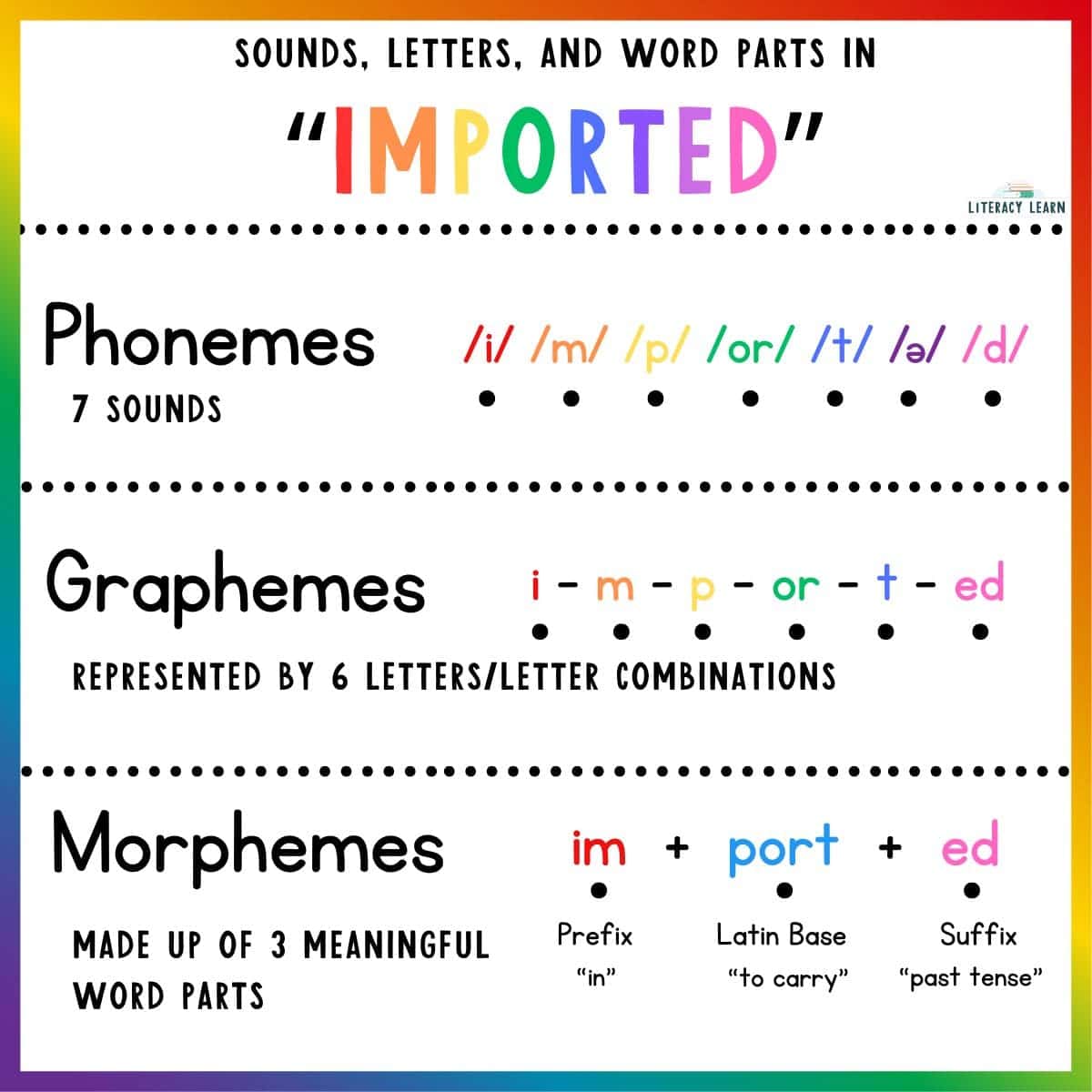
Let’s think about and analyze the word “imported.” The word “imported” is made up of 7 phonemes, 6 graphemes, and 3 morphemes. Isn’t that interesting?
What Is Phoneme-Grapheme Correspondence?
Students must understand how phonemes (sounds) correspond to graphemes (letter/letter units). This is called phoneme-grapheme correspondence. Other terms for this are sound-symbol relationships or phoneme-grapheme mapping.
Research rooted in the Science of Reading says that the brain must make explicit connections between phonemes and graphemes for decoding and encoding success.
It’s important that all teachers explicitly teach phoneme-grapheme correspondences. And this is especially important for students with reading deficits or disabilities like dyslexia.
If you’re a parent looking for support for your struggling reader, visit our Reading Tutoring Group.
Teaching Strategies for Phoneme-Grapheme Correspondences
Below we’ve listed research-aligned ideas for teaching phoneme-grapheme correspondences.
📜 Use a Scope and Sequence: Using a scope and sequence ensures that concepts are taught systematically, moving from the simple and most common to the more complex and less frequent.
Kids should master easier concepts before moving on to more difficult ones. Review this sample scope and sequence if you don’t already have one.
✍🏾 Incorporate Multimodal Techniques: Research tells us that multisensory learning that is authentic (reading, writing, listening, and speaking) AND engages a number of senses is the most effective type of instruction.
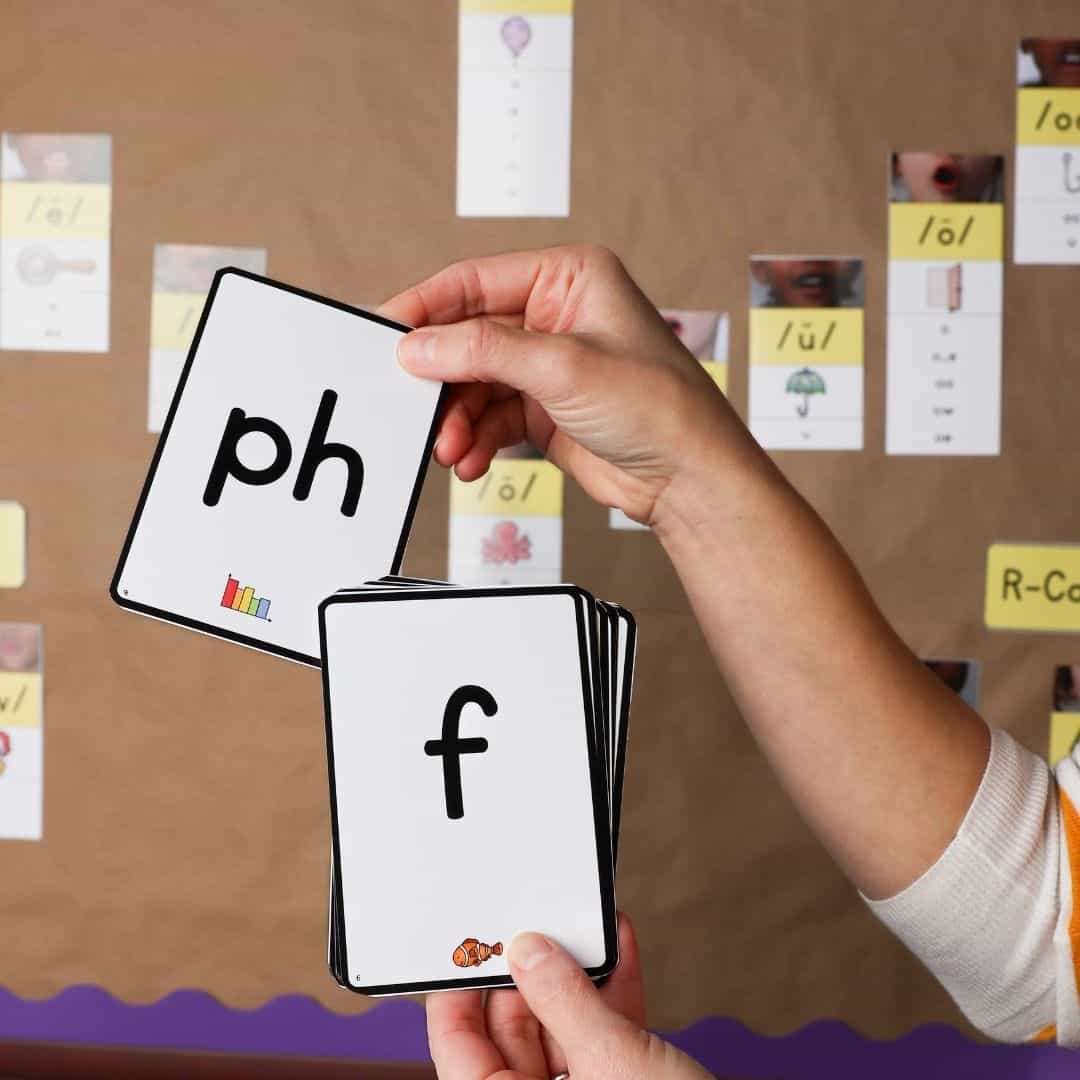
🔊🔡 Link Letters & Sounds: Include graphemes when practicing phonemic awareness skills like blending, segmenting, and phoneme manipulation.
Research has shown that including letters with PA instruction is most effective. To learn more about this, read our post that discusses Phonemic Awareness Practice with Letters.
👩🏾🏫 Provide Explicit Teaching. The University of Florida Literacy Institute suggests this procedure:
- Introduce the new grapheme and connect it with its corresponding phoneme.
- Explain where it might appear in words (beginning, middle or end).
- Demonstrate with sample words.
- Read new words.
- Select practice game and/or words from word lists or word card files to add for practice.
✏ Provide Lots of Practice Opportunities: Kids need lots of practice to make the sound-letter connections stick! Using SOR-supported activities for targeted practice. We recommend word ladders, phoneme-grapheme mapping activities, and sound-to-symbol mapping resources.
💡 Include a Sound Wall in your Classroom. Not only is a sound wall an important teaching tool, but students can use it as a scaffold as they work independently. It is one of the best tools to explicitly teach phoneme-grapheme correspondences.
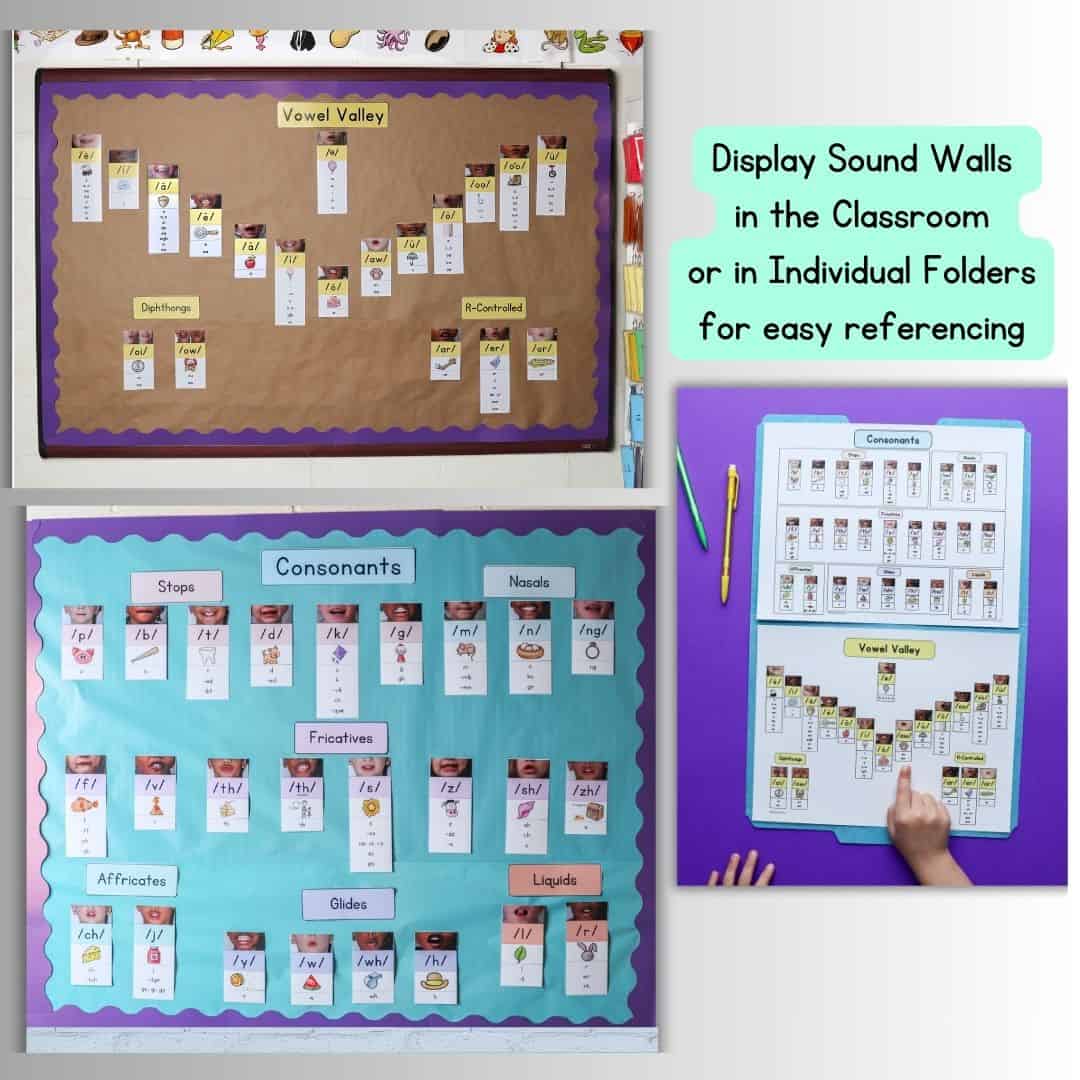
Teaching Morphemic Analysis
So we just talked all about why teaching sound-symbol relationships is important. But English is a morphophonemic language, meaning that it is “characterized by sound and form.”
In this definition, “form” relates to the morphemes that make up a word.
🐣 Consider the word “hatched” in the sentence: “The egg hatched.” We hear four phonemes: /h/, /a/, /ch/, and /t/.
If we spelled the word based purely on phoneme-grapheme correspondences and applied the spelling rule that ‘tch’ follows a short vowel in a one-syllable word, we would likely spell it as “hatcht.”
However, understanding the structure (form) of the word helps us to recognize that “hatched” is the past tense form of “hatch.” So we must add a new morpheme to show past tense. So even though we hear the /t/ sound, we know to add the meaningful word part suffix “-ed.”
You see how we cannot rely soley on sound-symbol correspondences as we read and spell, especially as children get older and encounter many new multisyllabic words. So they must consider the structure of a word, an important component of the structured literacy approach.
That is why we must also teach morphemic analysis. Morphemic analysis is the term for breaking apart words into their morphemes.
Teaching kids common prefixes, suffixes and Greek and Latin bases is an important component to morphemic analysis. 🤩 Get free Morphology Worksheets for more targeted practice.
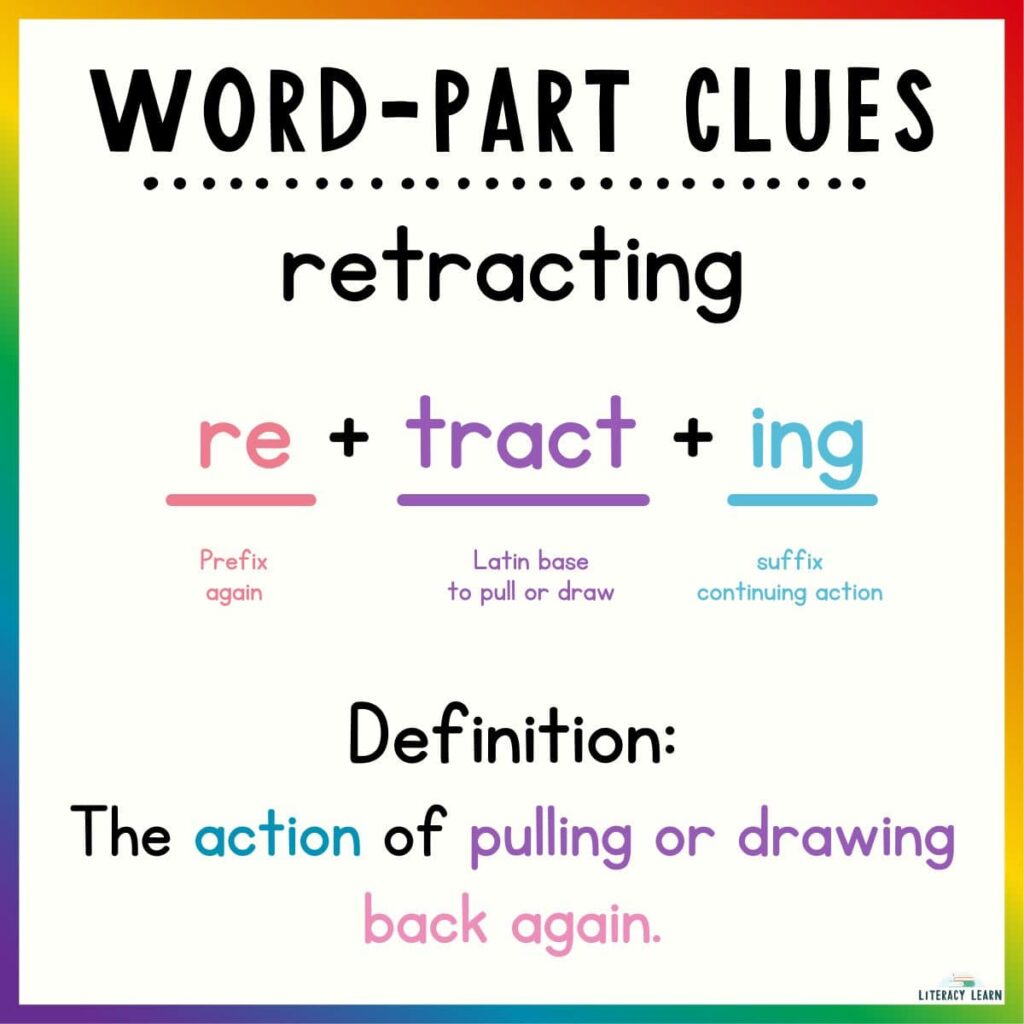
Benefits of Morphemic Analysis
There are lots of benefits to teaching morphemic analysis to your students.
- Morphemic analysis equips students to break down complex words into smaller, more manageable parts when decoding.
- Morphological knowledge improves students’ spelling skills. It gives kids a deep understanding of spelling patterns and knowledge of a word’s structure. For example, when a student is taught the suffix -ful (as in “wonderful“), they learn that the suffix is spelled with only one L at the end (as compared to the base word ‘full’ spelled with two L’s). Students can now apply this knowledge when spelling tons of words that will include the suffix -ful (fearful, hopeful, grateful, thankful, etc.).
- It builds vocabulary. Through morphemic analysis, kids learn new words and their meanings in deeper and more authentic ways. (Great activities for this are using word matrixes and word sums).
- Morphology deepens reading comprehension. By learning to analyze all word parts, students learn to understand unfamiliar words independently. This skill aids in a deeper understanding of texts across various content-area subjects.
Ultimately, morphological knowledge empowers students to become more proficient and autonomous readers.
This helps them gain independence and deepen comprehension while tackling increasingly challenging material as they progress in school.
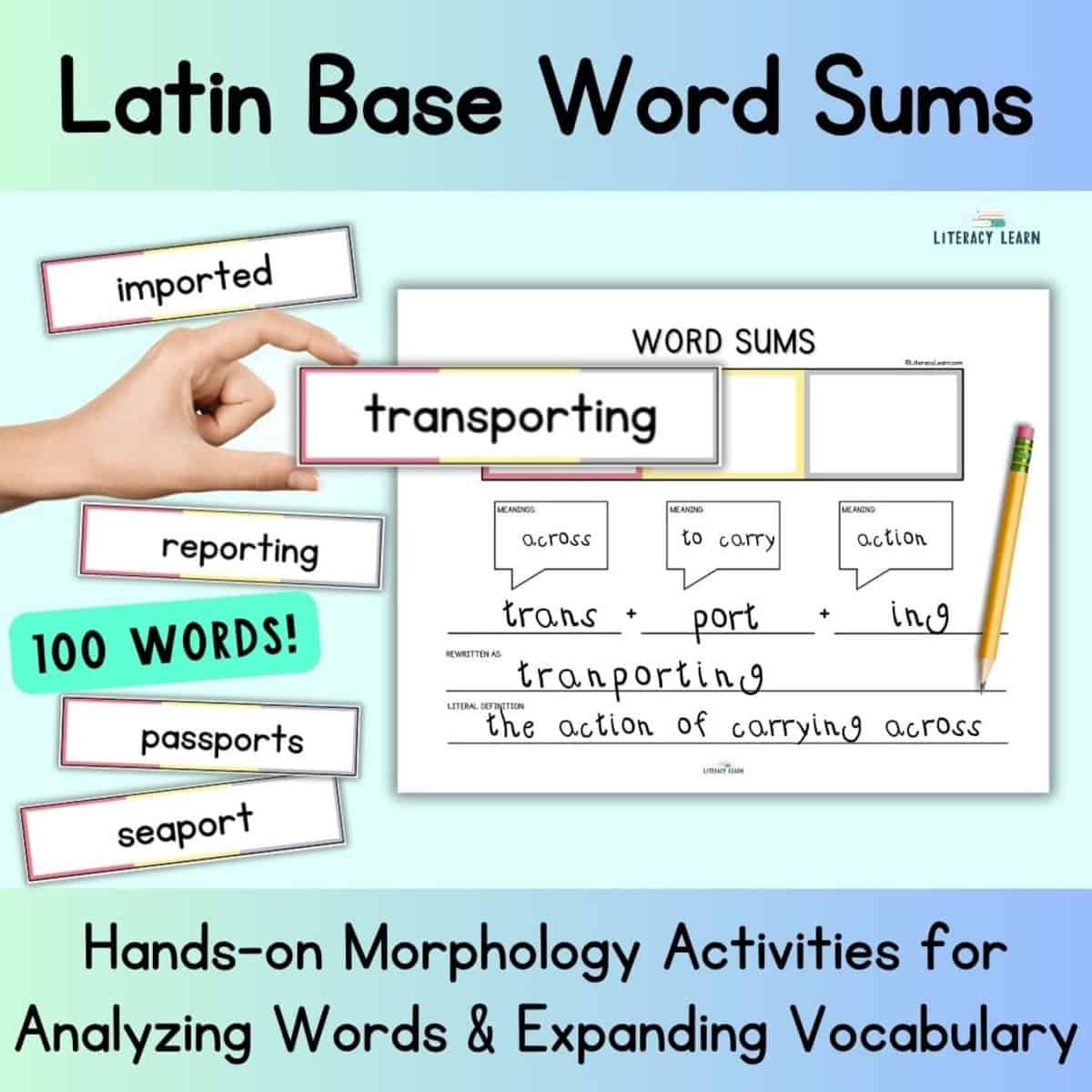
Conclusion
To summarize, it’s important to remember:
- Phonemes = Sounds
- Graphemes = Letter/Letters (Phonograms)
- Morphemes = Meaningful word parts
And because English is morphophonemic, it’s important that we teach both phoneme-grapheme correspondences and morphemic analysis.
We hope you now have the knowledge, inspiration, and practical resources to explicitly teach your students using these important components of structured literacy. This will ensure your students are on the path to reading and spelling success.

